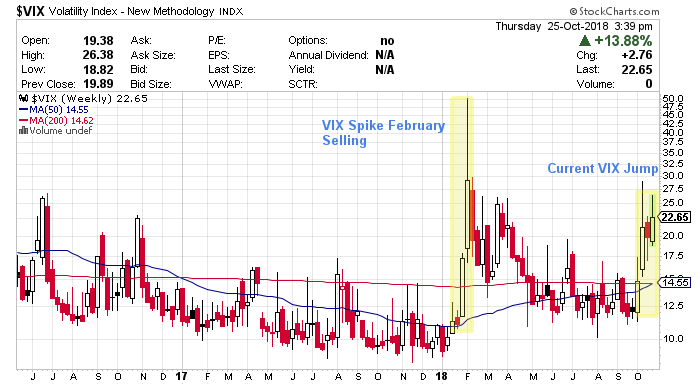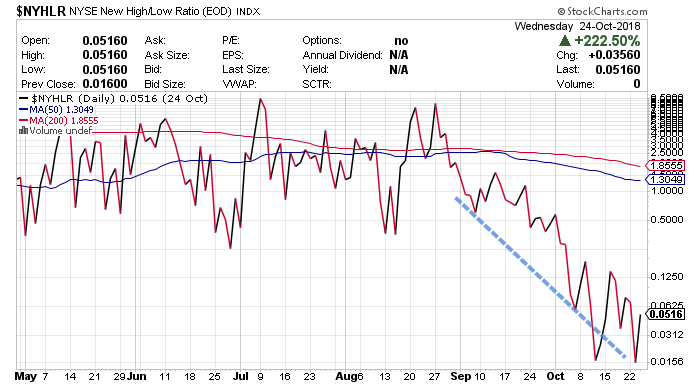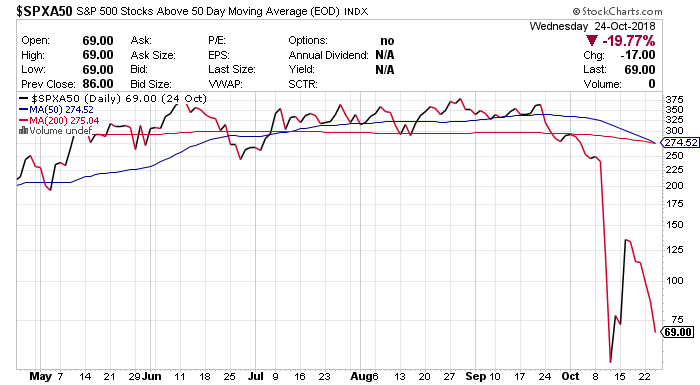Stock Market at Key Reflection Point: Why Bigger Is Better Now
Marijuana Business, Stocks, Finance, & Investing October 27, 2018 MJ Shareholders 0


Why the End of the Bull Run Has Not Yet Materialized
What started on a promising note in early January has turned sour after the sell-off on October 24 drove the Nasdaq and the Russell 2000 into a technical correction.
At the close, and prior to the oversold stock market buying that surfaced on October 25, the Dow Jones Industrial Average, the S&P 500, and the Russell 2000 indices turned negative on the year.
Of course, with this bout of selling capitulation in the stock market, albeit far less than what we viewed in early February, the bear pundits are re-surfacing.
I even heard one bear suggest that the stock market is vulnerable to a 50% correction.
Another bear said that more nastiness was coming, but it is interesting to note that this person has been calling for a major correction since 2009.
So while I do feel that the stock market is vulnerable to additional weakness, especially if yields move higher and the U.S.-China impasse isn’t resolved, I’m not suggesting you exit stocks and stuff your mattress with cash.
The reality is that the stock market is at a crux, which always surfaces after a major run-up in stocks, and we may be in the later stages of the bull market.
The Chicago Board Options Exchange (CBOE) Volatility Index (VIX) is trading above 20, but is still a ways off from the elevated reading of 50 during the early-February sell-off.
Chart courtesy of StockCharts.com
A closer look at the strength of the stock market shows a marked reversal in investor sentiment during the past several weeks.
Investor sentiment in the stock market is an important indicator to monitor, since it reflects the prevailing psychology of investors.
Chart courtesy of StockCharts.com
When investors are feeling gloomy like they are now, there will be a hesitancy to bid stocks higher. Of course, sentiment can easily reverse.
On the charts, October has been a wrecking ball for the stock market and, in particular, the risk on trade or higher beta stocks that tend to fall faster in a downturn.
When the stock market is rising, higher beta stocks tend to perform better and deliver alpha to investors.
At this point, the Nasdaq, the Dow Jones, the S&P 500, and the Russell 2000 are trading below their respective 50-day and 200-day moving averages. That’s a bearish sign.
Small-cap stocks are faring the worst, with the Russell 2000 down a staggering 12.9% in October and down 15.2% from its high (as of October 24).
Chart courtesy of StockCharts.com
The Nasdaq pulled out of its correction after the over-three percent bounce on October 25.
For now, the key will be whether the stock market can find some stability, but with the uncertainties in the midterm elections, yields, and trade, you should expect more volatility.
The technical picture is bearish for the stock market at this point.
The S&P 500 sold off after a bearish double top around 2,890. To make matters worse, only 18.5% of S&P 500 stocks are above their 50-day moving average, and 33.7% are above their 200-day moving average.
A look at the S&P 100 shows a similar situation, with only 17.6% and 44.1% of the stocks sitting above the respective moving averages.
Chart courtesy of StockCharts.com
Analyst Take
While a search for a bottom in the stock market may not be over, I don’t feel a that a bear market is yet upon us, since the economy and earnings remain strong.
As a trader, you need to be prudent and selectively add to positions after major selling in the stock market. For now, look at adding lower beta large-cap stocks on dips, since these stocks tend to be less volatile than the small-caps in times of uncertainty.
MJ Shareholders
MJShareholders.com is the largest dedicated financial network and leading corporate communications firm serving the legal cannabis industry. Our network aims to connect public marijuana companies with these focused cannabis audiences across the US and Canada that are critical for growth: Short and long term cannabis investors Active funding sources Mainstream media Business leaders Cannabis consumers














No comments so far.
Be first to leave comment below.